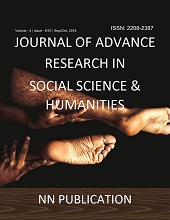Motivation in Language Learning Process
DOI:
https://doi.org/10.53555/nnssh.v6i1.822Keywords:
learner motivation, integrative/instrumental motivation, extrinsic/intrinsic motivation, global/situational/task motivation, promoting motivationAbstract
There are a lot of factors which influence success in language learning. However, one of the most important factors is the learner’s motivation to learn the language in order to be able to use it in real-life situations. Research and experience show that learners with strong motivation can achieve a lot regardless of circumstances. Studies of motivation in second language learning have led to several distinctions, one of which is the distinction between integrative and instrumental motivation. According to this distinction, some learners are motivated to learn the language because they want to integrate into the target language community, while for others the driving force is their desire to achieve personal goals. Another distinction related to motivation is the distinction between extrinsic motivation, which is regulated from an external source, and intrinsic motivation, which is regulated from within. And according to a third distinction, there can be global, situational and task motivation. Even though teachers cannot control all types and aspects of motivation, they can do a lot to help learners develop motivation and interest for learning the language. This paper discusses the importance of motivation, the different types of motivation and the ways of promoting learner motivation and interest.
References
• Ausubel, D. A. (1968). Educational Psychology: A Cognitive View. New York: Holt, Rinehart & Winston.
• Brown, H. D. (1987). Principles of Language Learning and Teaching. (2nd ed.). Englewood Cliffs, New Jersey: Prentice Hall.
• Brown, H. D. (2007). Principles of Language Learning and Teaching. (5th ed.). New York: Pearson Education.
• Conttia Lai M. W. (2007). The Influence of Learner Motivation on Developing Autonomous Learning in an English-for-Specific-Purposes Course. A dissertation submitted in partial fulfillment of the requirements for the Degree of M A in Applied Linguistics at the University of Hong Kong.
• Daskalovska Nina & Others. (2012). Learner motivation and interest. Procedia - Social and Behavioral Sciences.
• Deci, E. (1975). Intrinsic Motivation. New York: Plenum Press.
• Harmer. J. (1991). The Practice of English Language Teaching. Harlow: Longman.
• Harmer, J. (2001). The Practice of English Language Teaching. (3rd ed.) Harlow: Longman.
• Hedge, T. (2000). Teaching and Learning in the Language Classroom. Oxford: Oxford University Press.
• Gardner, R. C. (1985). Social Psychology and Second Language Learning: the Role of Attitudes and Motivation. London: Edward Arnold.
• Gardner, R. C. and Lambert, W. E. (1972). Attitudes and Motivation in Second Language Learning. Rowley, Mass.: Newbury House.
• Gardner, R. C., Smythe, P. C. & Brunet, G. R. (1977). Intensive second language study: effects on attitudes, motivation and French achievement. Language learning 27, 243-262.
• Naiman, N., Froelich, M., Stern, H. H. & Todesco, A. (1978). The Good Language Learner. Research in Education Series, No. 7, Toronto: Ontario Institute for Studies in Education.
• Ur, P. (1991). A Course in Language Teaching: Practice and Theory. Cambridge: Cambridge University Press.
• Ushioda, E. (2010). Socializing students’ motivation and autonomy in the English language classroom. Plenary talk at 44th Annual International IATEFL Conference and Exhibition, Harrogate, 7-11 April.
Published
Issue
Section
License

This work is licensed under a Creative Commons Attribution-NonCommercial-NoDerivatives 4.0 International License.
You are free to:
- Share — copy and redistribute the material in any medium or format for any purpose, even commercially.
- Adapt — remix, transform, and build upon the material for any purpose, even commercially.
- The licensor cannot revoke these freedoms as long as you follow the license terms.
Under the following terms:
- Attribution — You must give appropriate credit , provide a link to the license, and indicate if changes were made . You may do so in any reasonable manner, but not in any way that suggests the licensor endorses you or your use.
- No additional restrictions — You may not apply legal terms or technological measures that legally restrict others from doing anything the license permits.
Notices:
You do not have to comply with the license for elements of the material in the public domain or where your use is permitted by an applicable exception or limitation .
No warranties are given. The license may not give you all of the permissions necessary for your intended use. For example, other rights such as publicity, privacy, or moral rights may limit how you use the material.




